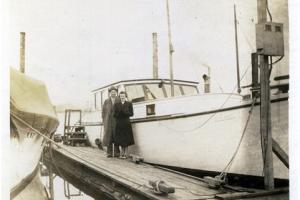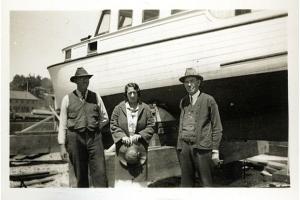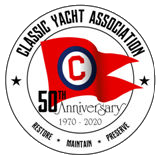Historical Summary:
AFTON HISTORY
When I bought Afton in May 2013 the seller didn’t know much about her history. While cleaning out a drawer, I found an old USCG document (literally under a pile of rusty old fishing tackle) which said the boat had been built in 1935, in North Bend, OR, by Neil Banks. I googled his name, and that brought up a book: a short history of North Bend published by a local maritime and history museum.
I called the museum and asked if they had any more information about Neil Banks or a boat called the Afton. The museum (which actually had a set of Neil’s woodworking tools on display in their maritime exhibit), put me in touch with Neil’s niece, Mary Granger, who was then 98 years old. We spoke by phone several times, and I then traveled to North Bend to meet Mary in person.
It turns out that Mary’s father, Robert Banks, had been half owner of a shipyard in North Bend, OR, called Kruse & Banks. The yard built big wood ships, and at its peak during World War I, the yard employed more than 600 workers. They built cargo ships for the war effort in WWI, and they built minesweepers and tug boats for the Navy in WWII. They also built the last great wood sailing schooners launched on the west coast. Neil Banks was Mary’s uncle – Robert’s brother. Neil worked in the yard by day doing fine finish carpentry on ship interiors.
Meeting Mary set me on the journey to track down former owners and piece together as much history as possible. Here’s what I know so far:
1935: Afton is built by Neil Banks at the Kruse & Banks Shipyard in North Bend, OR (on Coos Bay). She was a personal side project of Neil’s – so she was built AT the yard, but not BY the yard. Afton was the second of three small cruisers Neil built for himself. The first one, Heather II, was built in the late 20’s or early 30’s. Mary has a photograph of the boat, but does not know what became of her. Afton was completed in 1935. As far as I know it was a custom design by Neil himself, possibly with help from naval architects at Kruse & Banks. Mary gave me three photos of Afton from the 1930’s.
1939: Neil completed his third and final boat, Aurora. Mary also has pictures of the Aurora under construction and after completion. I assume that Neil sold Afton after he finished Aurora, but I don’t know when he sold it or to whom. From 1939 to 1956 Afton’s history is a mystery.
1956: That old USCG document I found on board was dated July 1956. It identified the owners as L.W. & Elizabeth Wiley, of Port Blakely, WA (on Bainbridge Island). It also says the boat at that time had a 150 HP Kermath gas engine. I don’t know when the Wileys bought the boat, or from whom. I don’t know if they bought it from Neil Banks directly, or if somebody else brought the boat north first.
I do know however that it was the Wileys who had the cabin house redesigned in the 1950’s by Ed Monk Sr. I received copies of some of the plan drawings from another former owner, and in 2014 I exchanged emails with Ed Monk Jr., who confirmed that his father’s records showed a redesign of the deck house of Afton for Mr. Wiley (Plan No. 2226). That explains the small bronze plaque in the salon that says “Built by Foss Boat & Joiner.” They didn’t build the boat originally; they did the 1950’s remodel based on the Monk plans.
Early 1960’s: The boat is purchased by B. Sinclair Wilt, a doctor on Bainbridge Island. I spoke with Wilt’s son in March 2014. He told me that his father bought the boat from the Wileys. He also remembers his father replaced the old gas engine with the current six cylinder diesel at some point in the late 70’s or early 80’s. Wilts sent out a family holiday card in the early 60’s showing all of their kids posed on the bow wearing matching sailor outfits. He sent me a copy.
June 3, 1988: Wilt sells the boat to Thomas D. Haggar, another doctor on Bainbridge. Wilt had retired from practicing medicine two years earlier, and had sold his medical practice to Haggar. Haggar told me that when Wilt first offered to sell him the boat he tried to decline. But Wilt said it would mean a lot to him to know the boat was in good hands, and Haggar felt like he couldn’t refuse. So in 1988 he bought the boat. Less than a year later Wilt died. Haggar renamed the boat “Sinclair” in Wilt’s honor. He says he doesn’t remember when the transom was repainted, but he knows he made the decision while Wilt was still alive. “I told him I was doing it, and that made him happy.” When I bought the boat in 2013 she still had the name “Sinclair” on the transom, and the fiberglass dinghy had the name “Sinny” painted on the side. That was Wilt’s nickname.
Tom Haggar also told me it was Wilt who installed the diesel engine, although he’s not sure when. Haggar also confirmed that the cabin house redesign was done for the Wileys in the 1950’s by Ed Monk Sr., with construction done by “Foss Boat & Joiner” in Port Blakely. Haggar sent me copies of the Monk plans. It was Monk who changed the design of the cabin house to its current configuration, with three large windows on each side instead of four small ones.
Early 1990’s. Haggar was keeping the boat in Eagle Harbor marina, inside a floating boat house. There was a large snow storm, and the boat house collapsed under the weight of the snow. There was substantial damage to the boat. The boat house itself nearly sank, and the mooring lines nearly pulled the boat down with it. Haggar says they had to cut the mooring lines to free the boat from being dragged down, and doing so was very dangerous due to all the tension on the lines. The boat was saved, and the wreckage of the boat house was taken ashore and burned.
June 2001: Receipts found on board show work performed at Dockside Sales and Service in Port Orchard, WA. Work included bottom paint, replacing zincs, head plumbing, revarnishing the transom, repainting the boot stripe, servicing the engine, rewiring the batteries, installing new DC electrical panel, installing red dot heater, and installing volt meter and engine hour meter.
February 2013: Title is transferred to Wendell Gregory a friend of Haggar’s son.
May 2013: I purchased the boat from Gregory. Within days after purchasing the boat, I discovered the 1956 USCG document in a drawer (literally under a pile of rusty old fishing tackle), which gave me the name “Neil Banks,” and started me down the path of piecing together the history.
January – March 2014: “Sinclair” is hauled at Canal Boat Yard in Seattle, and spends two months on the hard for the first major phase of her restoration. The work includes stripping and repairing the decks, replacing several planks and repairing other spots of soft wood in the hull, removing and replacing the mahogany skin on the transom, installation of a new rudder and keel shoe, and more. The new transom is finished with the original name Afton, done in an art deco font based on flatware we found in the galley engraved with the boat’s name.
April 2014: Mary Granger’s son and daughter travel from Oregon to attend a formal renaming ceremony where we rechristen her Afton.








 This yacht has been accepted and is currently registered as a Classic vessel with the Classic Yacht Asssociation.
This yacht has been accepted and is currently registered as a Classic vessel with the Classic Yacht Asssociation.